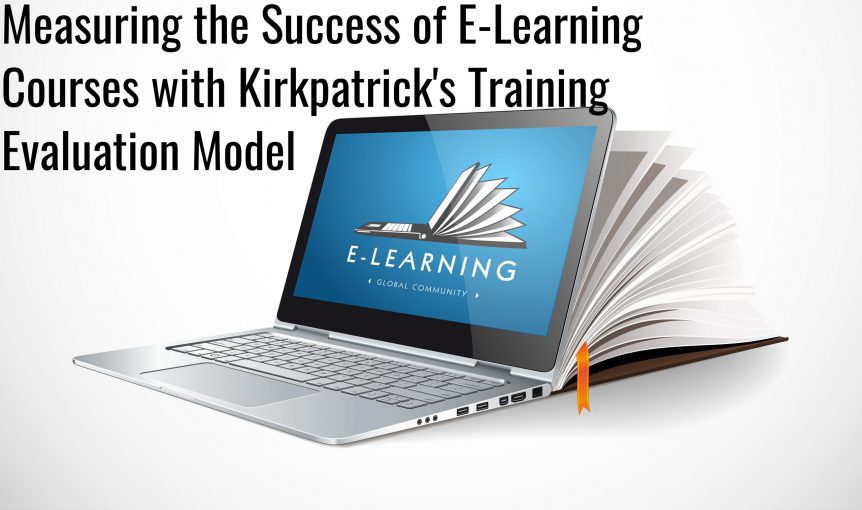Measuring the Success of E-Learning Courses with Kirkpatrick’s Training Evaluation Model
Measuring whether a training course is successful or not is a challenge faced by companies across the UAE and Saudi Arabia. It is even more difficult to measure return on investment.
Metrics like completion rates, results of quizzes, and employee feedback surveys are all helpful, but they don’t give the full picture of the success of your e-learning course. They also don’t provide you with enough information to assess ROI.
Kirkpatrick’s training evaluation model is a solution to these challenges. It creates a structure for e-learning and training evaluation to help you maximise the impact of your overall strategy and measure ROI.
What is Kirkpatrick’s Training Evaluation Model?
Kirkpatrick’s training evaluation model was developed in the late 1950s by University of Wisconsin professor Donald Kirkpatrick. It has been updated and revised since then, with the current model widely regarded as an effective method of evaluating workplace training. This includes e-learning training courses as well as other training content.
In Kirkpatrick’s training evaluation model, there are four distinct levels of training evaluation:
- Reaction
- Learning
- Behaviour
- Results
Level 1 – Reaction
The first level involves the reaction of learners to the training. The aim is to find out whether the learners found the e-learning course engaging, useful, and relevant to their day-to-day experience. You can also use it to find out what learners didn’t like about the course, what they thought could be improved, and whether they would recommend it.
It is also often useful to ask learners what additional training, help, or resources they think they need in order to apply the training in their job.
In e-learning, the process of getting this feedback is straightforward, as you can direct learners to a feedback form immediately after they complete the course. A professional e-learning developer will be able to design this form so it is quick and easy to complete while still providing useful and actionable information.
Level 2 – Learning
This level is about assessing how much people have learned after completing your e-learning course. It is an assessment that takes place at the end of the course, so it provides a comparison with what the learner knew before the course and what they know now.
For the best results, you should start by deciding on the objectives of the course, i.e., what do you want your team to learn. For many courses, it is also helpful to create an assessment, usually in the form of a quiz, at the start of the course so you can get a baseline to make a comparison.
The assessment you put at the end of the course should tie in with your course objectives. That assessment can be a quiz, but scenarios and gamification elements can also be effective tools to evaluate learning.
Level 3 – Behaviours
As you move to this level of the training evaluation model, the evaluation process takes a longer period of time. The first stage is to assess behavioural change, i.e., has the training resulted in the behavioural change that you wanted to achieve. In simple terms, are employees applying the skills and knowledge they learned in the training to their day-to-day tasks and how they work?
When this assessment should take place will depend on your organisation and the training topic, but you should plan it to be several months – up to six months is ideal. This is to ensure you get meaningful information that isn’t over-estimated with people who apply the learning immediately after the training but then go back to the old way of doing things.
Assessing behavioural change is largely a subjective process that can involve observation, interviewing learners, and interviewing managers. In some situations, objective assessments might also be possible, such as assessing productivity statistics or sales data.
If you discover there isn’t the level of behavioural change that you had hoped for, the next stage is to go through a process of understanding why. It could be the training, but other factors could also be at play. Properly understanding why people are not using the skills and/or knowledge they have learned will help you find an effective solution.
Level 4 – Results
This is the level where you measure tangible results. With this evaluation process, you should look at outcomes the business has achieved, breaking that down to ROI where possible, or other measurements that are important to your business.
Let’s look at an example using a health and safety training course:
- Level 1 (Reaction) – learners liked the e-learning course, and they thought it was interesting and engaging.
- Level 2 (Learning) – an assessment via a quiz indicated that learners understood the content at the end of the course.
- Level 3 (Behaviour) – managers and supervisors report that employees have adjusted their behaviours to work in a safer way.
- Level 4 (Results) – there have been fewer days of work since the training, which translates to an increase in productivity worth…
Giving Structure to Your Training Evaluation Process
The main benefit of Kirkpatrick’s training evaluation model is that it provides you with a clear process for evaluating individual training courses. That process also highlights areas that you can work on improving.
The model also works with a range of training approaches, including e-learning, and it gives your organisation a more comprehensive overview of the impact that training is having on your business. It is highly flexible, too, as it is effective in most situations.
By implementing Kirkpatrick’s training evaluation model in your organisation, there will be less guesswork involved in course content and strategy, plus you’ll have a much clearer picture of the returns on investment being achieved.
